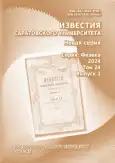Background and Objectives: A brief biography of Valery Tuchin, head of Optics and Biophotonics Department of Saratov State University, Doctor of Physical and Mathematical Sciences, Professor, Corresponding Member of the Russian Academy of Sciences is presented; his contribution to laser physics and biophotonics is discussed. Summary: Scientific activity of Valery Tuchin in the 60s was associated with laser physics. His interests included fluctuations in laser radiation, dynamic processes in gas-discharge lasers, and modulation characteristics of lasers. In the mid-80s, Professor Valery Tuchin began to create his own scientific school in the field of tissue optics, which eventually developed into the interdisciplinary science of biomedical photonics, and pioneered “tissue optical clearing” as a new direction. Over the years, the results achieved have received international recognition. Tuchin’s students continue to move along a given vector, developing his ideas and achieving great success and recognition not only in Russia but also abroad. He generously shares ideas with colleagues, connecting Saratov State University with scientific groups around the world. His authority and charisma, as well as his tremendous energy and efficiency, make it possible to implement great international projects, conferences and symposiums. Valery Tuchin is the organizer and inspirer of the Saratov Fall Meeting, which is widely known in the scientific world. Thanks to Valery Tuchin, students and young scientists from Saratov State University were among the first in Russia to have the opportunity to listen to lectures of heads of leading scientific groups, present and discuss their results, establish scientific and friendly connections with peers from other cities of the world. From 1989 to the present, Valery Tuchin has been the permanent head of the Optics and Biophotonics Department at Saratov State University. Conclusion: Professor Valery Tuchin is a unique example of both an outstanding scientist and a talented teacher and organizer of the scientific process. He have created a scientific school known all over the world. His fruitful scientific and educational activities have marked by the awarding of medals, orders, honorary titles and prizes from the State and various scientific communities, as SPIE, OCA, Laser Association of the Russian Federation and others.
 4-18
4-18


 19-29
19-29


 30-40
30-40


 41-51
41-51


 52-61
52-61


 62-75
62-75


 76-87
76-87


 88-97
88-97











